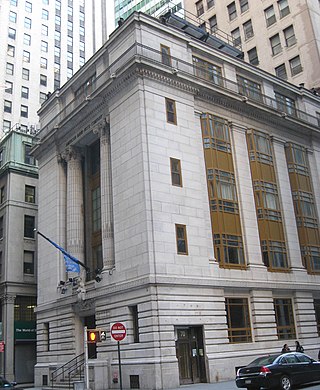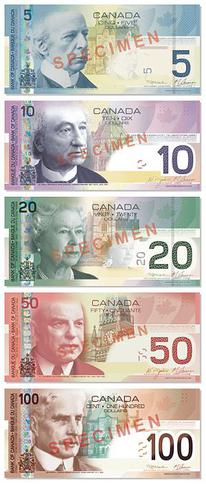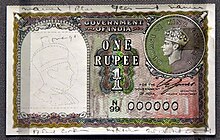The Kwacha is the currency of Zambia. It is subdivided into 100 Ngwee.

An overprint is an additional layer of text or graphics added to the face of a postage or revenue stamp, postal stationery, banknote or ticket after it has been printed. Post offices most often use overprints for internal administrative purposes such as accounting but they are also employed in public mail. Well-recognized varieties include commemorative overprints which are produced for their public appeal and command significant interest in the field of philately.

A banknote—also called a bill, paper money, or simply a note—is a type of negotiable promissory note, made by a bank or other licensed authority, payable to the bearer on demand. Banknotes were originally issued by commercial banks, which were legally required to redeem the notes for legal tender when presented to the chief cashier of the originating bank. These commercial banknotes only traded at face value in the market served by the issuing bank. Commercial banknotes have primarily been replaced by national banknotes issued by central banks or monetary authorities.
Large denominations of United States currency greater than $100 were circulated by the United States Treasury until 1969. Since then, U.S. dollar banknotes have been issued in seven denominations: $1, $2, $5, $10, $20, $50, and $100.

The Pakistani rupee is the official currency in the Islamic Republic of Pakistan. The issuance of the currency is controlled by the State Bank of Pakistan. It was officially adopted by the Government of Pakistan in 1949. Earlier the coins and notes were issued and controlled by the Reserve Bank of India until 1949, when it was handed over to the Government and State Bank of Pakistan, by the Government and Reserve Bank of India.

Banknotes of the Philippine peso are issued by the Bangko Sentral ng Pilipinas for circulation in the Philippines. The smallest amount of legal tender in wide circulation is ₱20 and the largest is ₱1000. The front side of each banknote features prominent people along with buildings, and events in the country's history while the reverse side depicts landmarks and animals.

The EURion constellation is a pattern of symbols incorporated into a number of secure documents such as banknotes, checks, and ownership title certificates designs worldwide since about 1996. It is added to help imaging software detect the presence of such a document in a digital image. Such software can then block the user from reproducing banknotes to prevent counterfeiting using colour photocopiers.

Security printing is the field of the printing industry that deals with the printing of items such as banknotes, cheques, passports, tamper-evident labels, security tapes, product authentication, stock certificates, postage stamps and identity cards. The main goal of security printing is to prevent forgery, tampering, or counterfeiting. More recently many of the techniques used to protect these high-value documents have become more available to commercial printers, whether they are using the more traditional offset and flexographic presses or the newer digital platforms. Businesses are protecting their lesser-value documents such as transcripts, coupons and prescription pads by incorporating some of the features listed below to ensure that they cannot be forged or that alteration of the data cannot occur undetected.

The karbovanets or karbovanet, also known as kupon or coupon, has been a distinct unit of currency in Ukraine during three separate periods of the 20th century. It is also a predecessor currency of today's Ukrainian hryvnia.

Counterfeit money is currency produced outside of the legal sanction of a state or government, usually in a deliberate attempt to imitate that currency and so as to deceive its recipient. Producing or using counterfeit money is a form of fraud or forgery, and is illegal in all jurisdictions of the world. The business of counterfeiting money is nearly as old as money itself: plated copies have been found of Lydian coins, which are thought to be among the first Western coins. Before the introduction of paper money, the most prevalent method of counterfeiting involved mixing base metals with pure gold or silver. Another form of counterfeiting is the production of documents by legitimate printers in response to fraudulent instructions. During World War II, the Nazis forged British pounds and American dollars. Today, some of the finest counterfeit banknotes are called Superdollars because of their high quality and imitation of the real US dollar. There has been significant counterfeiting of Euro banknotes and coins since the launch of the currency in 2002, but considerably less than that of the US dollar.

The Manchukuo yuan was the official unit of currency of the Empire of Manchuria, from June 1932 to August 1945.

The Confederate States dollar was first issued just before the outbreak of the American Civil War by the newly formed Confederacy. It was not backed by hard assets, but simply by a promise to pay the bearer after the war, on the prospect of Southern victory and independence. As the Civil War progressed and victory for the South seemed less and less likely, its value declined. After the Confederacy's defeat, its money had no value, and individuals and banks lost large sums.

Fractional currency, also referred to as shinplasters, was introduced by the United States federal government following the outbreak of the Civil War. These low-denomination banknotes of the United States dollar were in use between 21 August 1862 and 15 February 1876, and issued in denominations of 3, 5, 10, 15, 25, and 50 cents across five issuing periods. The complete type set below is part of the National Numismatic Collection, housed at the National Museum of American History, part of the Smithsonian Institution.

ABCorp, formerly the American Bank Note Company, is an American corporation providing contract manufacturing and related services to the authentication, payment and secure access business sectors. Its history dates back to 1795 as a secure engraver and printer, and assisting the newly formed First Bank of the United States to design and produce more counterfeit resistant currency. The company has facilities in the United States, Canada, Australia, and New Zealand.
Scenes of Canada is the fourth series of banknotes of the Canadian dollar issued by the Bank of Canada. It was first circulated in 1970 to succeed the 1954 Canadian Landscape series and was followed by the 1986 Birds of Canada banknote series. This was the last series to feature a $1 bill, which was replaced by a $1 coin known as the loonie in 1987, although both the $1 bill and the loonie were produced concurrently for 21 months, from June 1987 to April 1989.

Canadian Journey is the sixth series of banknotes of the Canadian dollar designed and circulated by the Bank of Canada. It succeeded the 1986 Birds of Canada banknote series. The first banknote of the Canadian Journey series issued into circulation was the $10 bill on 17 January 2001, and the last to be issued was the $50 bill on 17 November 2004. The series was succeeded by the 2011 Frontier Series, the banknotes of which were first issued into circulation from 2011 to 2013.
The paper money of the Hungarian korona was part of the circulating currency in the post-World War I Kingdom of Hungary until the introduction of the pengő in 1927. The variety of the banknotes and treasury notes and the variety of issuing authorities reflect the chaotic postwar situation in the country.

The Cruzado Novo was the short-lived currency of Brazil between 15 January 1989 and 15 March 1990. It replaced the cruzado in the rate of 1000 cruzados = 1 cruzado novo. It had the symbol and the ISO 4217 code BRN. In 1990, the cruzado novo was renamed the (third) cruzeiro. This currency was subdivided in 100 centavos.

Birds of Canada is the fifth series of banknotes of the Canadian dollar issued by the Bank of Canada and was first circulated in 1986 to replace the 1969 Scenes of Canada series. Each note features a bird indigenous to Canada in its design. The banknotes weigh 1 gram with dimensions of 152.40 by 69.85 millimetres. It was succeeded by the 2001 Canadian Journey series.

Banknotes of the euro, the common currency of the eurozone, have been in circulation since the first series was issued in 2002. They are issued by the national central banks of the Eurosystem or the European Central Bank. The euro was established in 1999, but "for the first three years it was an invisible currency, used for accounting purposes only, e.g. in electronic payments". In 2002, notes and coins began to circulate. The euro rapidly took over from the former national currencies and slowly expanded around the European Union.

















